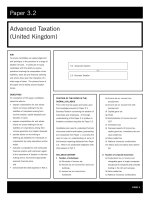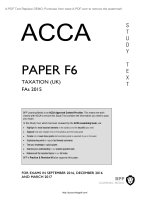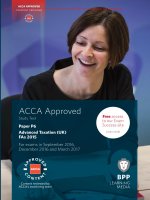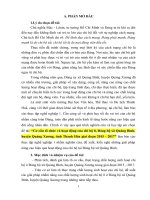BPP ACCA p6 advanced taxation FAs 2015 2017
Bạn đang xem bản rút gọn của tài liệu. Xem và tải ngay bản đầy đủ của tài liệu tại đây (8.58 MB, 722 trang )
ACCA APPROVED
Paper P6
Advanced Taxation (UK) FAs 2015
This ACCA Study Text for Paper P6 Advanced
Taxation (UK) FAs 2015 has been comprehensively
reviewed by the ACCA examining team. This review
guarantees appropriate depth and breadth of content
and comprehensive syllabus coverage.
For exams in September 2016,
December 2016 and March 2017
BPP House
142-144 Uxbridge Road
London W12 8AA
United Kingdom
T 0845 075 1100 (UK)
T +44 (0)20 8740 2211 (Overseas)
E
bpp.com/learningmedia
• A user-friendly format for easy navigation
• Exam focus points describing what the examining
team will want you to do
• Regular Fast Forward summaries emphasising the
key points in each chapter
• Questions and quick quizzes to test your
understanding
• A practice question bank containing exam-
standard questions with answers
• A full index
• All you need in one book
Study Text
Contact us
In addition to ACCA examining team reviewed
material you get:
Advanced Taxation (UK) FAs 2015
BPP Learning Media is dedicated to supporting aspiring business professionals
with top-quality learning material as they study for demanding professional
exams, often whilst working full time. BPP Learning Media’s commitment
to student success is shown by our record of quality, innovation and market
leadership in paper-based and e-learning materials. BPP Learning Media’s study
materials are written by professionally qualified specialists who know from
personal experience the importance of top-quality materials for exam success.
ACCA P6
ACCA approved content provider
A-PDF Text
Replace
DEMO: Purchase from www.A-PDF.com to remove the watermark
CONTENT
PROVIDER
ACCA Approved
Study Text
Paper P6
Advanced Taxation (UK)
FAs 2015
Free access
to our Exam
Success site
Look inside
For exams in September 2016,
December 2016 and March 2017
February 2016
£32.00
/>
ACP6ST16 (RICOH).indd 1-3
05/02/2016 10:59
ACCA APPROVED CONTENT PROVIDER
As the first accredited publisher of ACCA materials, BPP Learning Media has set the benchmark for
producing exceptional study materials for students and tutors alike.
Our Study Texts, Practice & Revision Kits and i-Passes (for exams on demand) are reviewed by the ACCA
examining team and are written by our in-house authors with industry and teaching experience who
understand what is required for exam success.
EXAM SUCCESS SITE
To help maximise your chances of succeeding in your exams, we’ve put together a suite of exclusive ACCA
resources. Our Exam Success site provides you with access to a free digital version of this publication, as
well as extra resources designed to focus your efforts on exams and study methods.
To access the Exam Success site, please email with the subject line “Access to Exam
Success site - eBook”, including your order reference number and the name of the book you’ve bought (ie
ACCA F5 Study Text) for your access code. Once you have received your code, please follow the instructions
below:
To access the BPP ACCA Exam Success site for this material
please go to:
www.bpp.com/ExamSuccessSite
n Create a user account if you don’t already have one.
Make sure you reply to the confirmation email.
n Log in using your registered username and password.
Select the paper you wish to access.
n Enter the code you received when prompted. You will only
have to do this once for each paper you are studying.
/>
S
T
U
D
Y
PAPER P6
ADVANCED TAXATION
FAs 2015
BPP Learning Media is an ACCA Approved Content Provider. This means we work
closely with ACCA to ensure this Study Text contains the information you need to pass
your exam.
In this, ACCA examination-team reviewed Study Text we:
Discuss the best strategies for studying for ACCA exams
Highlight the most important elements in the syllabus and the key skills you will need
Signpost how each chapter links to the syllabus and the study guide
Provide lots of exam focus points demonstrating what is expected of you in the exam
Emphasise key points in regular fast forward summaries
Test your knowledge of what you've studied in quick quizzes
Examine your understanding in our practice question bank
Reference all the important topics in our full index
BPP's Practice & Revision Kit also supports this paper.
FOR EXAMS IN SEPTEMBER 2016, DECEMBER 2016
AND MARCH 2017
/>
T
E
X
T
First edition 2007
Ninth edition February 2016
A note about copyright
Dear Customer
ISBN 9781 4727 4432 6
(Previous ISBN 9781 4727 2240 9)
eISBN 9781 4727 4674 0
What does the little © mean and why does it matter?
British Library Cataloguing-in-Publication
Data
A catalogue record for this book is available
from the British Library
Published by
Your market-leading BPP books, course materials and elearning materials do not write and update themselves. People
write them on their own behalf or as employees of an
organisation that invests in this activity. Copyright law protects
their livelihoods. It does so by creating rights over the use of
the content.
Breach of copyright is a form of theft – as well as being a
criminal offence in some jurisdictions, it is potentially a serious
breach of professional ethics.
BPP Learning Media Ltd
BPP House, Aldine Place
142-144 Uxbridge Road
London W12 8AA
With current technology, things might seem a bit hazy but,
basically, without the express permission of BPP Learning
Media:
www.bpp.com/learningmedia
Printed in the United Kingdom by
RICOH UK Limited
Unit 2
Wells Place
Merstham
RH1 3LG
Your learning materials, published by BPP Learning Media
Ltd, are printed on paper obtained from traceable
sustainable sources.
All rights reserved. No part of this publication may be
reproduced, stored in a retrieval system or transmitted, in
any form or by any means, electronic, mechanical,
photocopying, recording or otherwise, without the prior
written permission of BPP Learning Media Ltd.
Photocopying our materials is a breach of copyright
Scanning, ripcasting or conversion of our digital
materials into different file formats, uploading them to
facebook or e-mailing them to your friends is a breach
of copyright
You can, of course, sell your books, in the form in which you
have bought them – once you have finished with them. (Is this
fair to your fellow students? We update for a reason.) Please
note the e-products are sold on a single user licence basis: we
do not supply 'unlock' codes to people who have bought them
secondhand.
And what about outside the UK? BPP Learning Media strives to
make our materials available at prices students can afford by
local printing arrangements, pricing policies and partnerships
which are clearly listed on our website. A tiny minority ignore
this and indulge in criminal activity by illegally photocopying
our material or supporting organisations that do. If they act
illegally and unethically in one area, can you really trust them?
We are grateful to the Association of Chartered Certified
Accountants for permission to reproduce past
examination questions. The suggested solutions in the
practice answer bank have been prepared by BPP
Learning Media Ltd, unless otherwise stated.
©
BPP Learning Media Ltd
2016
ii
/>
Contents
Page
Introduction
Helping you to pass
Studying P6
The exam paper
Syllabus and study guide
v
vii
ix
xii
Part A Income tax and national insurance contributions
1
2
3
4
5
6
7
8
9
10
Principles of income tax
Pensions and other tax efficient investment products
Property and other investment income
Employment income
Employment income: additional aspects
Trade profits
Capital allowances
Trading losses
Partnerships and limited liability partnerships
Overseas aspects of income tax
3
25
45
57
89
107
135
155
171
181
Part B Capital gains tax
11
12
13
14
Chargeable gains: an outline
Shares and securities
Chargeable gains: reliefs
Chargeable gains: additional aspects
205
219
231
259
Part C Tax administration for individuals
15
Self assessment for individuals and partnerships
283
Part D Inheritance tax
16
17
18
An introduction to inheritance tax
Inheritance tax: valuation, reliefs and the death estate
Inheritance tax: additional aspects
307
325
347
Part E Stamp taxes
19
Stamp taxes
365
Part F Corporation tax
20
21
22
23
24
25
26
27
Computing taxable total profits
Chargeable gains for companies
Computing corporation tax payable
Administration, winding up, purchase of own shares
Losses and deficits on non-trading loan relationships
Close companies and investment companies
Groups and consortia
Overseas aspects of corporate tax
377
397
413
427
437
451
459
475
Part G Value added tax
28
29
Value added tax 1
Value added tax 2
495
513
Part H Impact of taxes and tax planning
30
Impact of taxes and tax planning
535
Contents
/>
iii
Practice question and answer bank
Tax tables
Index
Review form
iv
Contents
/>
581
673
679
Helping you to pass
BPP Learning Media – ACCA Approved Content Provider
As ACCA’s Approved Content Provider, BPP Learning Media gives you the opportunity to use study
materials reviewed by the ACCA examination team. By incorporating the examination team’s comments
and suggestions regarding the depth and breadth of syllabus coverage, the BPP Learning Media Study
Text provides excellent, ACCA-approved support for your studies.
The PER alert
Before you can qualify as an ACCA member, you not only have to pass all your exams but also fulfil a three
year practical experience requirement (PER). To help you to recognise areas of the syllabus that you
might be able to apply in the workplace to achieve different performance objectives, we have introduced
the ‘PER alert’ feature. You will find this feature throughout the Study Text to remind you that what you
are learning to pass your ACCA exams is equally useful to the fulfilment of the PER requirement.
Your achievement of the PER should now be recorded in your on-line My Experience record.
Tackling studying
Studying can be a daunting prospect, particularly when you have lots of other commitments. The
different features of the Study Text, the purposes of which are explained fully on the Chapter features
page, will help you whilst studying and improve your chances of exam success.
Developing exam awareness
Our Study Texts are completely focused on helping you pass your exam.
Our advice on Studying P6 outlines the content of the paper and the necessary skills you are expected to
be able to demonstrate and any brought forward knowledge you are expected to have.
Exam focus points are included within the chapters to highlight when and how specific topics were
examined, or how they might be examined in the future.
Using the Syllabus and Study Guide
You can find the syllabus and study guide on page xii of this Study Text.
Testing what you can do
Testing yourself helps you develop the skills you need to pass the exam and also confirms that you can
recall what you have learnt.
We include Questions – lots of them – both within chapters and in the Practice Question Bank, as well as
Quick Quizzes at the end of each chapter to test your knowledge of the chapter content.
Introduction
/>
v
Chapter features
Each chapter contains a number of helpful features to guide you through each topic.
Topic list
Topic list
Syllabus reference
Tells you what you will be studying in this chapter and the
relevant section numbers, together with ACCA syllabus
references.
Introduction
Puts the chapter content in the context of the syllabus as
a whole.
Study Guide
Links the chapter content with ACCA guidance.
Exam Guide
Highlights how examinable the chapter content is likely to
be and the ways in which it could be examined.
Knowledge brought forward from earlier studies
What you are assumed to know from previous
studies/exams.
FAST FORWARD
Summarises the content of main chapter headings,
allowing you to preview and review each section easily.
Examples
Demonstrate how to apply key knowledge and
techniques.
Key terms
Definitions of important concepts that can often earn you
easy marks in exams.
Exam focus points
Tell you when and how specific topics were examined, or
how they may be examined in the future.
Formula to learn
Formulae that are not given in the exam but which have to
be learnt.
This gives you a useful indication of syllabus areas that
closely relate to performance objectives in your Practical
Experience Requirement (PER).
Give you essential practice of techniques covered in the
chapter.
Question
vi
Chapter Roundup
A full list of the Fast Forwards included in the chapter,
providing an easy source of review.
Quick Quiz
A quick test of your knowledge of the main topics in the
chapter.
Practice Question Bank
Found at the back of the Study Text with more
comprehensive chapter questions. Cross referenced for
easy navigation.
Introduction
/>
Studying P6
As the name suggests, this paper examines Advanced Taxation. It builds on the foundations of Paper F6 in
two ways. First, it introduces more advanced taxation topics in relation to inheritance tax and specialised
personal and corporate tax. Second, it requires the ability to communicate clearly with clients,
HM Revenue & Customs and other professionals in a clear and professional manner. It is an options paper
which will be chosen by those who work in a tax environment.
Members of the P6 examination team have written several articles in Student Accountant which are also
available on the ACCA website. There are four non-technical articles that focus on the structure of the
exam and exam technique. These are Stepping up from Paper F6(UK) to Paper P6(UK), Examiner's
approach to Paper P6 (UK), Guidance on answering questions in Section A of Paper P6 (UK) and
Improving your performance in Paper P6 (UK). There are also technical articles covering the following
topics: Exam technique and fundamental technical issues for Paper P6 (UK), Taxation of the
unincorporated business – the new business, Taxation of the unincorporated business – the existing
business, International aspects of personal taxation, Inheritance tax and capital gains tax for P6, Trusts
and tax for P6, Corporation tax for P6, Corporation tax– group relief for P6, Corporation tax– groups and
chargeable gains for P6, and Finance Acts 2015. Make sure you read these articles to gain further insight
into what the examination team is looking for.
1 What P6 is about
The P6 syllabus builds on the basic knowledge of core taxes gained from F6 and introduces candidates to
additional capital taxes in the form of stamp duty, stamp duty reserve tax and stamp duty land tax. It also
extends knowledge of income tax, inheritance tax, corporation tax and capital gains taxes, including
overseas aspects, taxation of trusts and additional exemptions and reliefs.
The emphasis of the paper is on the candidate’s skills of analysis and interpretation of information
provided and communication of recommendations in a manner appropriate to the intended audience eg
clients. Computations will normally only be required in support of explanations or advice and not in
isolation.
2 What skills are required?
Be able to calculate tax charges in support of explanations or advice.
Be able to explain the tax charges in a particular scenario: what taxes are applicable and why.
Be able to analyse a set of facts to ascertain when tax charges arise and any options that may be
available to the taxpayer to mitigate such charges.
Be able to evaluate your results and recommend a course of action, justifying your
recommendations and setting out any other factors which the taxpayer should take into account
when reaching his decision.
3 How to improve your chances of passing
Study the entire syllabus – 60 marks of the marks available to you are contained in the compulsory
Section A questions. Section B questions allow you to show more specialised knowledge and allow the
examination team to test a wide range of topics.
Practice as many questions as you can under timed conditions – this is the best way of developing good
exam technique. Make use of the Practice Question Bank at the back of this Text. BPP's Practice and
Revision Kit contains numerous exam standard questions (many of them taken from past exam papers)
as well as three mock exams for you to try.
Answer selectively – the examination team will expect you to consider carefully what is relevant and
significant enough to include in your answer. Don't include unnecessary information.
Introduction
/>
vii
Present your answers in a professional manner – use subheadings and leave spaces between paragraphs,
make sure that your numerical workings are clearly set out.
Answer all parts of the question – leaving out a five mark part may be the difference between a pass and a
fail.
4 Brought forward knowledge
The P6 syllabus covers almost every topic that was included in F6, with a few minor exceptions. Since tax
law changes every year, this text includes all the topics covered at F6 again, updated to the latest Finance
Act(s). At the start of each chapter, we highlight topics which have changed between the latest Finance
Act(s) and the previous Finance Act. We also highlight new topics which you have not studied at F6.
5 Gaining professional marks
As P6 is a Professional level paper, four professional marks will be awarded in Question 1. Professional
marks will usually be awarded for overall presentation of the required letter or memorandum, the
provision of relevant advice and the effectiveness with which the information is communicated.
Whatever the form of communication requested, you will not gain professional marks if you fail to follow
the basics of good communication. Keep an eye on your spelling and grammar. Also think carefully, am I
saying things that are appropriate in a business communication?
viii
Introduction
/>
The exam paper
The time allowed for the paper is 3 hours 15 minutes.
The paper consists of two sections:
Section A consists of two compulsory questions. Question 1 will have 35 marks, including four
professional marks, and question 2 will have 25 marks. Professional marks are awarded for aspects such
as adopting a logical approach to problem solving, clarity of calculations, the effectiveness with which
information is communicated and the overall presentation of the required memorandum, notes or letter.
There are no set topics for Section A questions, but you should expect to see coverage of technical
taxation topics new at P6, such as international aspects, and tax planning and interaction of taxes.
Section B consists of three questions, two of which must be answered. Each question will have 20 marks.
Again, there are no set topics, but you might expect to find more specialist questions concentrating on
such areas as advanced corporation tax (for example, dealing with close companies or advising on the tax
effects of purchase of own shares by a company), advanced personal tax (for example, advising on tax
advantaged share schemes) or advanced capital taxes (for example, dealing with trusts).
All questions are scenario based and will normally involve consideration of more than one tax, together
with some elements of planning and the interaction of taxes. Computations will normally only be required
in support of explanations or advice and not in isolation. For example, you might be asked to advise on
how to extract money from a company in a tax efficient manner such as by a bonus payment, dividend or
loan. You would be expected to produce computations to support your advice.
Tax rates, allowances and information on certain reliefs will be given in the exam paper. These will be the
same as shown in the Tax Tables at the end of this Text. You should familiarise yourself with the
information provided so that you know how to find it quickly in the exam.
Introduction
/>
ix
Analysis of past papers
The table below provides details of when each element of the syllabus has been examined in the ten most
recent sittings and the question number and section in which each element was examined.
Covered
in Text
chapter
Sept/
Dec
2015
June
2015
Dec
2014
June
2014
Dec
2013
June
2013
Dec
2012
June
2012
Dec
2011
June
2011
3(b),
5(a)
1(b)
1(a),
4(a),
5(c)
5(a)
3(a)
2(a)
4(c)
2(a)
1(a)
3(b)
3(a)
INCOME TAX
1
Principles of income tax
1(a),
2(b),
5(a)
2
Pensions and other tax
efficient investment
products
5(a),
5(b)
3
Property and other
investment income
4(b)
4(b)
4(a)
5(a)
4
Employment income
1(a),
4(a)
5(a)
3(a),
5(c)
4(c)
3(a),
5(b)
2(a)
3(b),
3(c)
3(b)
5
Employment income:
additional aspects
5(b)
3(b),
3(c)
5(b)
5(b)
1(a),
2(a)
4(a)
3(a)
6
Trade profits
5(b)
4(a)
1(a)
2(a)
3(b),
4(b)
2(a)
3(a)
7
Capital allowances
3(a)
2(a)
1(a),
5(b)
4(b)
1(a)
5(c)
8
Trading losses
1(b)
1(b)
5(a)
2(a)
2(a)
3(b)
9
Partnerships and limited
liability partnerships
10
Overseas aspects of
income tax
1(a)
1(a)
1(b)
4(c)
4(b)
4(b)
1(a)
4(b)
4(a)
1(a),
3(d)
3(b)
1(a),
2(a)
3(b)
2(b)
CAPITAL GAINS TAX
11
Chargeable gains: an
outline
12
Shares and securities
13
Chargeable gains: reliefs
14
Chargeable gains:
additional aspects
1(a)
1(b),
3(b),
5(a)
2(b)
4(a)
1(a)
2(a)
3(b)
2(b)
1(c),
4(b)
3(c)
1(a),
5(b)
1(c),
3(a),
4(b),
5(c)
3(d)
4(b)
1(b),
3(b),
5(a)
1(a)
4(c)
2(b)
2(b),
4(a)
2(a)
4(a)
1(a)
2(a)
1(a)
2(a), (b)
TAX ADMINISTRATION
FOR INDIVIDUALS
15
1(b)
Self assessment for
individuals and
partnerships
4(c),
5(a),
5(b)
1(b)
INHERITANCE TAX
x
16
An introduction to
inheritance tax
5(b)
4(b)
1(a),
3(a)
1(b)
1(b),
3(a)
2(b)
2(b),
5(c)
1(a)
4(b)
1(b),
4(a)
17
Inheritance tax:
valuation, reliefs and the
death estate
1(b)
4(c)
3(b)
1(b)
3(a)
2(b)
5(c)
1(a)
4(b)
1(b)
18
Inheritance tax:
additional aspects
1(d),
4(c)
3(c)
4(c)
1(b),
3(c)
5(c)
1(a)
2(b), 4(a),
4(b)
1(b)
Introduction
/>
Covered
in Text
chapter
Sept/
Dec
2015
June
2015
Dec
2014
June
2014
Dec
2013
June
2013
Dec
2012
June
2012
Dec
2011
June
2011
STAMP TAXES
19
Stamp taxes
2(a)
2(b)
1(a)
1(a)
CORPORATION TAX
20
Computing taxable total
profits
2(a),
3(a),
4(b)
2(b)
2(a),
2(b)
21
Chargeable gains for
companies
2(b),
3(b)
2(a)
2(a),
2(c)
22
Computing corporation
tax payable
2(a)
23
Administration, winding
up, purchase of own
shares
24
Losses and deficits on
non-trading loan
relationships
25
Close companies and
investment companies
26
Groups and consortia
27
Overseas aspects of
corporate tax
2(a),
2(b)
2(b)
5(a)
2(a)
4(a)
2(a)
1(a)
1(c)
1(a)
2(b),
5(c)
1(a)
2(b),
2(c)
2(b),
3(a),
3(c)
2(a),
2(c)
2(a)
5(c)
2(b)
2(a)
2(a)
5(c)
2(d),
3(b),
5(a),
5(b)
1(a)
2(a)
1(a), 5(b)
1(a)
3(a),
3(b)
1(a)
4(b)
2(a)
3(a)
2(b)
3(a)
2(b),
5(c)
1(a)
2(a),
5(c)
1(a), 5(a)
3(b)
5(a),
(b)
VALUE ADDED TAX
28
Value added tax 1
2(b),
2(c)
1(d)
1(d)
29
Value added tax 2
4(c)
3(c)
2(c)
1(a),
5(a)
1(a)
2(d)
1(c)
1(a),
2(c)
4(c)
4(b)
2(c),
4(a)
1(b)
1(a)
1(a),
5(a)
1(a),
1(c),
1(d),
3(a)
1(b)
2(b), 5(c)
2(a),
(b)
2(b),
(c)
1(a), 5(c)
2(a),
(b)
1(b),
3(a)
1(b)
2(b)
IMPACT OF TAXES AND
TAX PLANNING
30
Impact of taxes and tax
planning
Introduction
/>
xi
Syllabus and Study Guide
The P6 Syllabus and Study Guide can be found below.
xii
Introduction
/>
Introduction
/>
xiii
xiv
Introduction
/>
Introduction
/>
xv
xvi
Introduction
/>
Introduction
/>
xvii
xviii
Introduction
/>
Introduction
/>
xix
xx
Introduction
/>
Introduction
/>
xxi
xxii
Introduction
/>
Introduction
/>
xxiii









